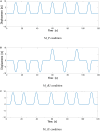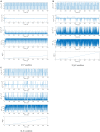Computational Model of Motion Sickness Describing the Effects of Learning Exogenous Motion Dynamics
- PMID: 33633547
- PMCID: PMC7899976
- DOI: 10.3389/fnsys.2021.634604
Computational Model of Motion Sickness Describing the Effects of Learning Exogenous Motion Dynamics
Abstract
The existing computational models used to estimate motion sickness are incapable of describing the fact that the predictability of motion patterns affects motion sickness. Therefore, the present study proposes a computational model to describe the effect of the predictability of dynamics or the pattern of motion stimuli on motion sickness. In the proposed model, a submodel - in which a recursive Gaussian process regression is used to represent human features of online learning and future prediction of motion dynamics - is combined with a conventional model of motion sickness based on an observer theory. A simulation experiment was conducted in which the proposed model predicted motion sickness caused by a 900 s horizontal movement. The movement was composed of a 9 m repetitive back-and-forth movement pattern with a pause. Regarding the motion condition, the direction and timing of the motion were varied as follows: (a) Predictable motion (M_P): the direction of the motion and duration of the pause were set to 8 s; (b) Motion with unpredicted direction (M_dU): the pause duration was fixed as in (M_P), but the motion direction was randomly determined; (c) Motion with unpredicted timing (M_tU): the motion direction was fixed as in (M_P), but the pause duration was randomly selected from 4 to 12 s. The results obtained using the proposed model demonstrated that the predicted motion sickness incidence for (M_P) was smaller than those for (M_dU) and (M_tU) and no considerable difference was found between M_dU and M_tU. This tendency agrees with the sickness patterns observed in a previous experimental study in which the human participants were subject to motion conditions similar to those used in our simulations. Moreover, no significant differences were found in the predicted motion sickness incidences at different conditions when the conventional model was used.
Keywords: computational model; learning; motion dynamics; motion pattern; motion sickness; prediction; sensory conflict theory; subjective vertical conflict theory.
Copyright © 2021 Wada.
Conflict of interest statement
The author declares that a patent application on the model has been recently submitted by Ritsumeikan University.
Figures






Similar articles
-
Construction of a computational model of individual progression of motion sickness symptoms based on subjective vertical conflict theory.Exp Brain Res. 2025 Apr 5;243(5):108. doi: 10.1007/s00221-025-07052-5. Exp Brain Res. 2025. PMID: 40186622 Free PMC article.
-
Validating models of sensory conflict and perception for motion sickness prediction.Biol Cybern. 2023 Jun;117(3):185-209. doi: 10.1007/s00422-023-00959-8. Epub 2023 Mar 27. Biol Cybern. 2023. PMID: 36971844 Free PMC article.
-
A computational model of motion sickness dynamics during passive self-motion in the dark.Exp Brain Res. 2023 Sep;241(9):2311-2332. doi: 10.1007/s00221-023-06684-9. Epub 2023 Aug 17. Exp Brain Res. 2023. Retraction in: Exp Brain Res. 2024 May;242(5):1251. doi: 10.1007/s00221-024-06838-3. PMID: 37589937 Retracted.
-
Modelling motion sickness and subjective vertical mismatch detailed for vertical motions.Brain Res Bull. 1998 Nov 15;47(5):537-42. doi: 10.1016/s0361-9230(98)00088-4. Brain Res Bull. 1998. PMID: 10052585 Review.
-
Motion sickness: a synthesis and evaluation of the sensory conflict theory.Can J Physiol Pharmacol. 1990 Feb;68(2):294-303. doi: 10.1139/y90-044. Can J Physiol Pharmacol. 1990. PMID: 2178753 Review.
Cited by
-
Construction of a computational model of individual progression of motion sickness symptoms based on subjective vertical conflict theory.Exp Brain Res. 2025 Apr 5;243(5):108. doi: 10.1007/s00221-025-07052-5. Exp Brain Res. 2025. PMID: 40186622 Free PMC article.
-
Amplitude and Temporal Dynamics of Motion Sickness.Front Syst Neurosci. 2022 May 9;16:866503. doi: 10.3389/fnsys.2022.866503. eCollection 2022. Front Syst Neurosci. 2022. PMID: 35615427 Free PMC article.
-
Validating models of sensory conflict and perception for motion sickness prediction.Biol Cybern. 2023 Jun;117(3):185-209. doi: 10.1007/s00422-023-00959-8. Epub 2023 Mar 27. Biol Cybern. 2023. PMID: 36971844 Free PMC article.
-
Modeling orientation perception adaptation to altered gravity environments with memory of past sensorimotor states.Front Neural Circuits. 2023 Jul 20;17:1190582. doi: 10.3389/fncir.2023.1190582. eCollection 2023. Front Neural Circuits. 2023. PMID: 37547052 Free PMC article.
-
Theoretical considerations on models of vestibular self-motion perception as inherent in computational frameworks of motion sickness.Biol Cybern. 2025 Aug 7;119(4-6):22. doi: 10.1007/s00422-025-01018-0. Biol Cybern. 2025. PMID: 40773048 Free PMC article.
References
-
- Bos J. E., Bles W., Groen E. L. (2007). A theory on visually induced motion sickness. Displays 29 47–57. 10.1016/j.displa.2007.09.002 - DOI
-
- Braccesi C., Cianetti F. (2011). Motion sickness. Part I: development of a model for predicting motion sickness incidence. Int. J. Hum. Factors Model. Simul. 2 163–187. 10.1504/IJHFMS.2011.044494 - DOI
LinkOut - more resources
Full Text Sources
Other Literature Sources

